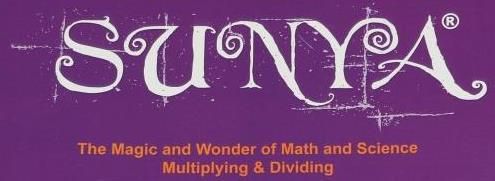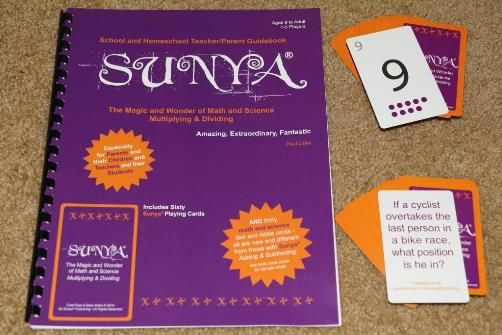
One of Lauren's favorite things is when I declare a "game day" for school. Our days would definitely be more enjoyable if I did a better job of incorporating educational games into our regular school days. Recently I added
Sunya -- The Magic and Wonder of Math and Science, Multiplying & Dividing, ages 9+ by
Sunya Publishing to our growing game collection.

The Sunya set came with a deck of 60 cards containing numbers, wild cards, and mathematical signs; a deck of 30 math and science riddle cards; a soft-cover instruction booklet; and a Sunya number line to help during the game.
I have to admit that I was a bit overwhelmed when I saw a twenty-five page book for the instructions. I took a deep breath and realized that the instructions for the basic game were only seven pages long. Still a bit much, but not quite so bad. As I read through the instructions carefully, I realized that the game itself was much more simple than I first thought.
Basically, the point of Sunya is to make number sentences (in this case, either multiplication or division sentences) with the cards. So far, we've only played the game as multiplication problems. It plays the same way when making division sentences.
The Sunya twist to simply making number sentences is that you can take advantage of the cards already in play to help make a correct equation. In the picture below, my husband made the number sentence 3 x 8 = 24 by using an 8 and a 4 card from his hand. The previous sentence had been 3 x 7 = 21. By placing his 8 on top of the 7 and his 4 on top of the 1 in the ones place of the answer, he got a new sentence.
As you may have noticed from our pictures, we've chosen not to hide our cards when we play (a suggestion I found in the Sunya instruction book). Lauren stays more engaged in the game when she's trying to help me figure out a way to use my cards and isn't just waiting for her next turn.
Like I said earlier, the instructions are rather long. As I read through them time and time again, it reminds me of the long list of house rules our family has developed for playing Monopoly. (For instance, collecting tax money and giving it away when someone lands on Free Parking.) The long explanations primarily add in extra tricks or rules that aren't absolutely necessary. We follow most of the easier rules about not putting a card down on a matching one and not putting cards down to reverse the initial equation, but I haven't introduced the more complicated rules to Lauren yet.
One of Lauren's favorite rules is the end of the game. The winner of Sunya is the first person to get rid of all the cards in their hand. That player plays his final turn and then declares, "Sunya!" which means empty. Lauren thinks this is a lot like trying to get rid of all her cards when playing Uno. In fact, she often yells, "Suno!" at the end of the game instead of "Sunya!"
After the winner calls "Sunya," they get to choose the top card from the math and science deck to read to the rest of the players. It's not necessarily an integral part of the game, but it adds a bit of fun to the end of each game. Sometimes Lauren and I figured out the answer to a card, but other times we skipped them.
Lauren loves getting to add the Sunya Publishing card game to our math lessons, and I like the way it challenges her thinking skills. She's learned to look at the cards and think through all the possible multiplication facts that can be created. She's not just answering rote multiplication problems on a worksheet, she's practicing all of her facts while playing.

©2009-2016 Through the Calm and Through the Storm. All rights reserved. Photos and content may not be reproduced. http://throughthecalmandthroughthestorm.blogspot.com









We liked the game too.
ReplyDeleteblessings, Dawn
It's a good game, glad we had a chance to review it. :)
ReplyDelete